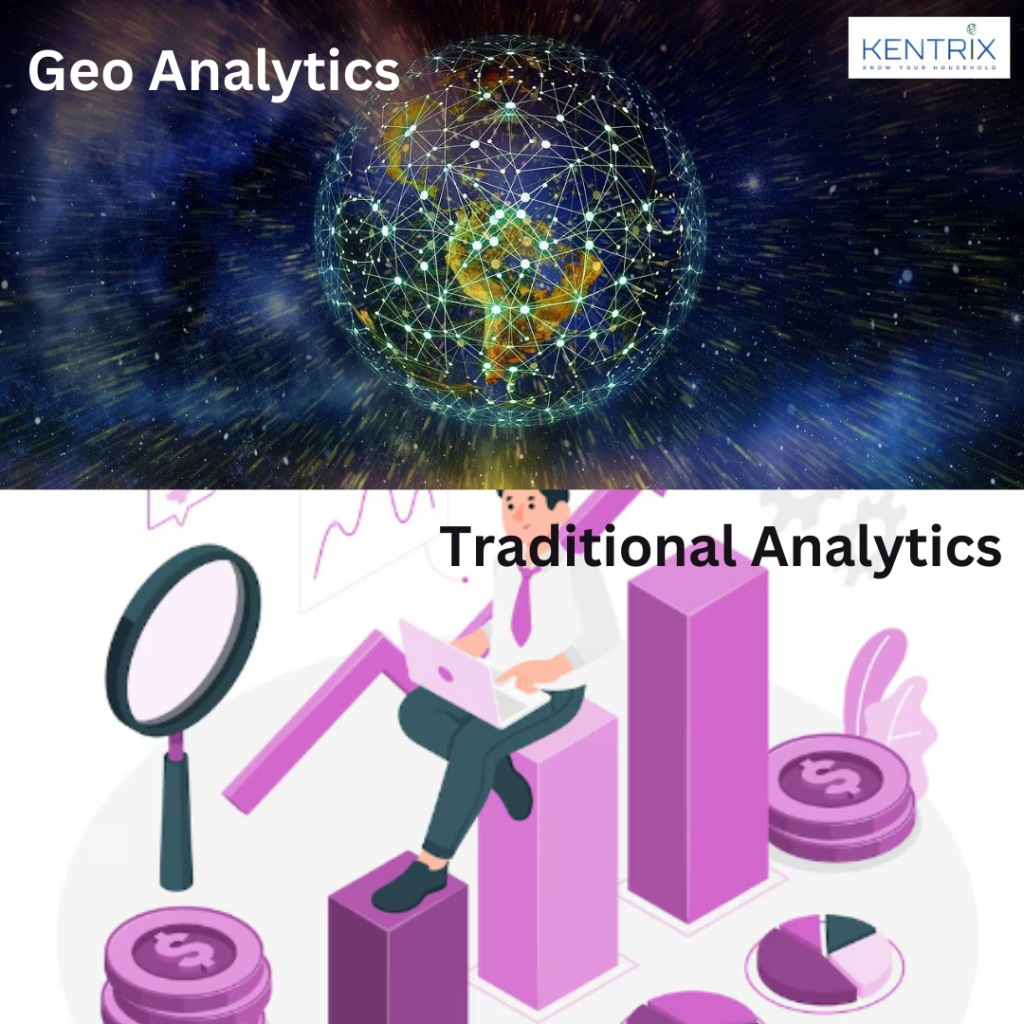In today’s world, data is the backbone of informed decision-making. Whether it’s understanding consumer behavior, improving operational efficiency, or predicting market trends, data analytics plays a crucial role in driving business success. But when it comes to analyzing data, businesses have two primary options: Geo Analytics and Traditional Analytics.
While traditional analytics has long been a staple in the business world, geo analytics adds a whole new dimension by incorporating location-based insights. So, which one wins in the battle of data analysis methods? Let’s dive into the key differences, advantages, and use cases to determine which one suits your needs better.
What is Traditional Analytics?
Traditional Analytics refers to the process of analyzing non-geographic data to uncover patterns, trends, and insights. It primarily deals with data that doesn’t have a spatial component, such as customer purchase history, website traffic, or sales figures. The primary goal is to make data-driven decisions based on historical data, trends, and forecasts.
Key Features of Traditional Analytics
- Focuses on numerical and categorical data.
- Involves the use of statistics, machine learning, and data mining techniques.
- Provides insights based on time-series data and predictive modeling.
Popular Tools in Traditional Analytics
- Excel: A basic yet widely used tool for data analysis.
- Tableau: A powerful platform for visual analytics and dashboards.
- SPSS: A statistical analysis tool commonly used in research and business.
What is Geo Analytics?
Geo Analytics takes traditional data analysis a step further by incorporating geographic or spatial data. This form of analysis enables businesses to visualize, understand, and interpret data with a spatial component, such as customer locations, delivery routes, and regional sales.
Key Features of Geo Analytics
- Focuses on spatial data (i.e., data tied to physical locations).
- Allows users to visualize data on maps.
- Provides insights into patterns related to geography, like sales by region or the density of customer traffic.
Popular Tools in Geo Analytics
- ArcGIS: A comprehensive platform for mapping and spatial analysis.
- Google Earth Engine: Offers large-scale geographic data processing.
- QGIS: An open-source alternative for geospatial data visualization and analysis.
Core Differences Between Geo Analytics and Traditional Analytics
When comparing the two, it’s essential to understand how they differ fundamentally:
- Data Interpretation Methods: Traditional analytics uses statistics and modeling techniques on non-geographic data, while geo analytics integrates spatial data into these models.
- Geographic vs. Non-Geographic Data: Traditional analytics doesn’t consider “where” something happens. Geo analytics, on the other hand, focuses on the location aspect of data.
- Visualization: Traditional analytics relies on graphs, charts, and dashboards, whereas geo analytics incorporates maps, heat maps, and location-based visuals.

Data Sources: Geographic Data vs. Standard Data
Traditional Analytics primarily works with data that comes from internal business systems, databases, and external third-party sources. This data typically includes sales figures, customer demographics, and operational metrics.
Geo Analytics takes it up a notch by adding location-based data from GPS systems, geographic information systems (GIS), satellite imagery, and location-tracking apps. This type of data helps businesses understand not just what is happening but where it’s happening.
Also Read : Why Every Business Needs India Location Analysis in 2024
Use Cases of Traditional Analytics
Traditional analytics has broad applications across numerous industries, including:
- Retail: Analyzing sales trends to predict future demand.
- Finance: Studying stock market trends and portfolio performance.
- Healthcare: Tracking patient outcomes and optimizing hospital operations.
Use Cases of Geo Analytics
Geo analytics is especially powerful in industries where location is a key factor:
- Logistics and Transportation: Optimizing delivery routes and tracking shipments in real-time.
- Retail: Understanding customer distribution to determine optimal store locations.
- Public Safety: Mapping crime patterns to allocate police resources effectively.
Advantages of Traditional Analytics
- Wide Adoption: Traditional analytics is well-established and understood by most businesses.
- Predictive Power: It excels in forecasting trends and behaviors based on historical data.
- Versatile: Applicable across a wide range of industries and use cases.
Advantages of Geo Analytics
- Location Insights: Geo analytics provides powerful insights into location-based patterns and behaviors.
- Enhanced Visualization: Maps and geospatial visuals offer clearer insights than standard graphs.
- Real-Time Analysis: Geo analytics can track data in real-time, making it invaluable for industries like logistics.
Challenges in Traditional Analytics
One key challenge in traditional analytics is the lack of location-based data, which can limit insights in industries where geography plays a critical role. Additionally, visualization in traditional analytics can become complex and cluttered when dealing with large datasets.
Challenges in Geo Analytics
Geo analytics, while powerful, comes with its own set of challenges, such as the complexity of spatial data integration and the cost of acquiring and maintaining location-based data systems. Additionally, geo analytics often requires specialized tools and expertise, which can be a barrier for smaller businesses.
When to Use Geo Analytics Over Traditional Analytics
If your business decisions rely on understanding location-based data – such as optimizing delivery routes, determining where to open new stores, or tracking the movement of people or products – then geo analytics is the clear winner.
When to Stick with Traditional Analytics
For businesses that primarily rely on time-series data or trends that aren’t tied to geographic location, traditional analytics remains the better option. It’s more cost-effective and easier to implement for standard data analysis tasks.
Combining Geo Analytics and Traditional Analytics
In some cases, the best approach may be to combine both methods. By integrating geographic insights with traditional data analytics, businesses can create a more comprehensive view of their operations, leading to better decision-making.
Conclusion
In the battle of Geo Analytics vs. Traditional Analytics, neither method is universally better. It all depends on your specific business needs. Geo analytics wins when location is a crucial factor, while traditional analytics remains the go-to for general data analysis. Often, the combination of both provides the most insightful results.
FAQs
- What industries benefit the most from geo analytics?
Industries like logistics, retail, and public safety benefit significantly from geo analytics due to their reliance on location-based data.
- Can small businesses use geo analytics effectively?
Yes, many tools and platforms make geo analytics accessible even for small businesses, allowing them to optimize local operations and target nearby customers.
- Is geo analytics expensive?
While advanced geo analytics tools can be costly, there are more affordable or open-source options, making it viable for businesses of all sizes.
- How is real-time data handled in geo analytics?
Geo analytics platforms often incorporate real-time data from GPS and tracking systems, enabling dynamic decision-making.
- What are the future trends in geo analytics and traditional analytics?
The integration of AI and machine learning with both traditional and geo analytics will continue to evolve, offering deeper insights and more predictive capabilities.


